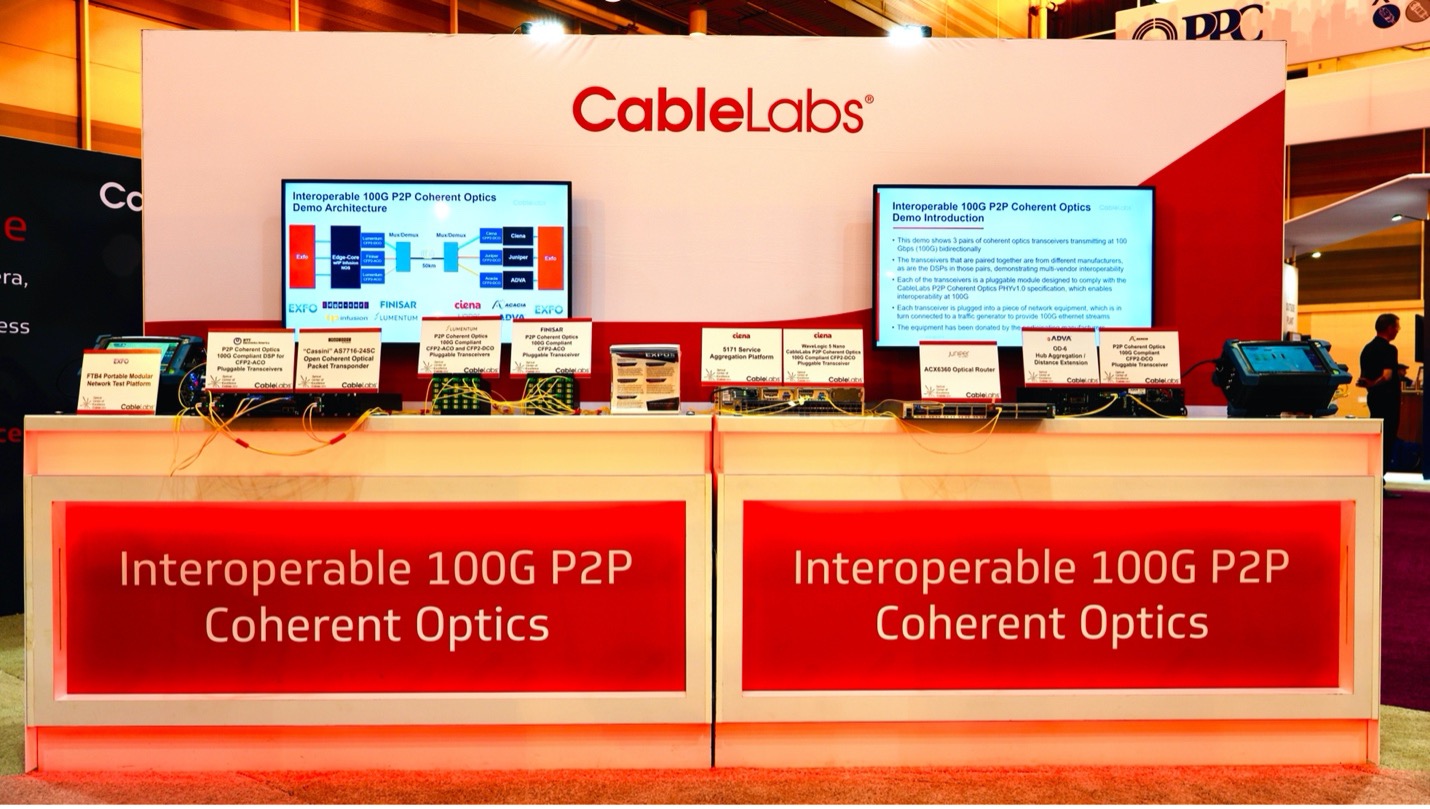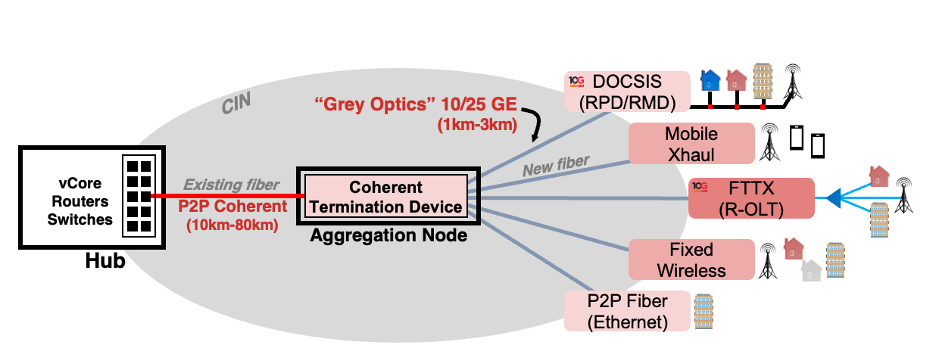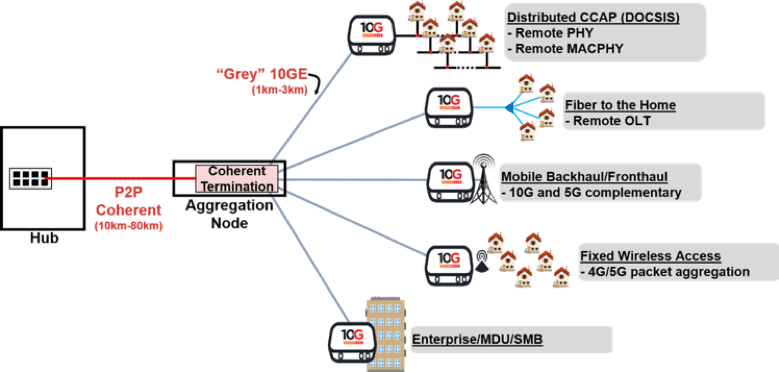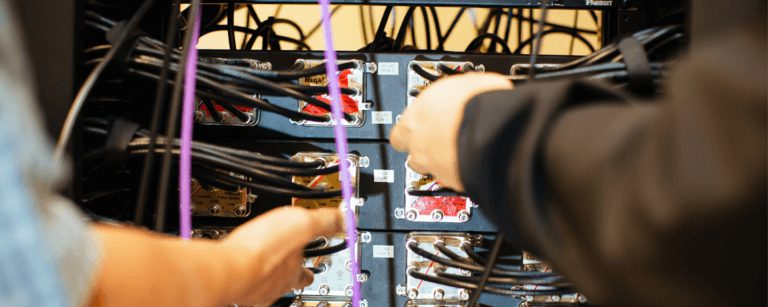Fiber
“Cable” Doesn’t Equal “Coax”: The Rise of Fiber Continues

Key Points
- Fiber-optic cable is becoming increasingly important for the broadband industry as operators develop new ways to leverage its capabilities.
- Since the 2023 release of the Coherent PON Architecture Specification, CableLabs has continued to work with member operators and the vendor community to develop the suite of specifications, which will enable the development and deployment of interoperable devices.
All too often, people equate the word “cable” with “coax” (aka coaxial cable), the insulated copper cable that cable companies have historically used to connect devices around the world and deliver information and entertainment. "Cable,” however, isn’t just made of metal but also of glass: fiber-optic cable (aka fiber).
The use of fiber in cable networks is nothing new. In fact, it’s been a dominant part of the industry for decades — hence, the F in HFC, which is short for hybrid fiber coax, the network architecture used in modern cable networks. That fiber is taking on increasing importance as cable operators develop new ways to leverage its capabilities. Leveraging the capabilities of that fiber is an essential part of evolving cable networks.
Cable operators are transitioning the fiber portions of their networks from analog to digital, increasing capacity and reliability. At the same time, they are pushing fiber deeper into the network and closer to the customer — and, in some cases, all the way to the customer. When that happens, it is referred to as fiber to the premises (FTTP), typically using passive optical network (PON) technology. But in all cases, fiber’s ability to scale to higher and higher capacities to support the applications of today and tomorrow is and will be a critical component for success across the cable industry.
In case you missed it, fiber’s increasing importance was on display at SCTE TechExpo 2024 this year in Atlanta. Multiple sessions covered a variety of topics ranging from the challenges of deploying FTTP, improving PON operations and management, and the history and evolution of PON technology.
Three of those sessions are now available to watch on demand:
- Practical Strategies for Deploying FTTH
- Boosting Performance: PNM for Optical Networks
- Operationalizing and Automating PON
An additional session went a step further to examine an emerging new technology that holds the promise of revolutionizing how we use the fiber in cable networks: coherent PON (CPON).
What Is CPON?
In May 2023, CableLabs announced the release of a new specification: the Coherent PON Architecture Specification. That specification provided an overview of how coherent technology could be applied to a PON to dramatically increase its potential: leveraging the improved sensitivity of coherent detection to improve spectral efficiency (which increases network capacity) while simultaneously extending the reach of the network across greater distances and higher split ratios.
The objective of CPON as laid out in that specification is to support 100 Gbps of capacity on a single wavelength that can be shared by up to 512 end users at today’s typical PON distances. Alternatively, CPON can be used to extend the reach of the network to 80 kilometers with fewer end users (in other words, a lower split ratio). Both of these features make the technology uniquely suited to existing cable operator networks without impacting its usefulness for non-cable operators, which promotes interoperability, scale and competition. Further, the CPON Architecture Specification envisions potential use cases for those enhanced capabilities, ranging from running fiber directly to business and residential customers to the aggregation of other networks’ devices, such as Remote PHY devices for DOCSIS 4.0 deployments or mobile xHaul equipment.
Of course, that was just the first step in bringing this new technology to life: CableLabs has continued to work with our members and the manufacturer community to develop the suite of specifications that will enable the development and deployment of interoperable devices. Extensive progress has been made to:
- refine operator requirements
- review contributions and proposals from the manufacturer community, cable operators and CableLabs engineers
- develop consensus around how the technology will work
And although that work isn’t yet finished, we’re starting to get a sense of what it might look like.
A CPON Vision
One of the TechExpo presentations was based on a paper titled “What Could You Do With 100 GBPS Coherent PON?” by Edward W. Boyd (Ciena), John Bender (GCI), Kevin Noll (CableLabs) and James Harley (Ciena). In this paper, the authors explore a possible CPON network that:
- has a full 100 Gbps of capacity (unlike other PON technologies, which operate at less than their advertised rate).
- supports tuning and multiple wavelengths in the C-band to enable CPON devices to operate over existing dense wave division multiplexing (DWDM) networks.
- adapts to different network deployment scenarios.
- supports the expansion of total network capacity in the future.
The paper also looks at how CPON could be applied to a variety of use cases, and how it can do so cost-effectively.
Enabling the CPON Vision
Although that presentation provided a vision of what CPON might look like when completed, another presentation looked at some other essential elements of CPON, including methods for keeping costs down and enabling burst operation (something new to coherent technology but a key part of the operation of a PON). That presentation was based on a paper titled “Unleashing the Power of Coherent Optical Technology,” authored by several CableLabs engineers: Haipeng Zhang, Zhensheng (Steve) Jia and L. Alberto Campos.
This paper examines several key topics:
- how to keep optical network unit (ONU) costs low using various technologies
- how to handle upstream burst transmissions efficiently and effectively
- how to adapt to different user requirements
- how to ensure CPON resilience and reliability to support a broader range of use cases than today’s PON systems
Getting Involved
Although these papers may or may not represent the technologies that will be a part of the final CPON solution, they do provide examples of the types of requirements and technology proposals that the CableLabs CPON Working Group is reviewing even now.
Many decisions have already been made, with the group moving at an impressively fast clip to wrap up key specification work in the coming year, but there’s still an opportunity to influence this emerging new technology. If you have the time and the expertise, we’re always looking to add more contributors with new perspectives and ideas to the group.
If that describes you and you’d like to get involved, please contact us using this form. Otherwise, keep an eye on this space as we continue to define this next-generation technology.
Wired
A Jolt of Light: CableLabs Holds First 200G P2P Coherent Optics Interop

Anyone remember the jingle for Jolt® Cola? All the sugar and twice the caffeine! Perhaps the phrase dates me, but I still hear it in my head—although I now have new words to set to it:
All the distance and twice the capacity!
OK, maybe it doesn’t have quite the same ring to it. But it’s still exciting because that’s what was demonstrated last month in our labs for Point-to-Point Coherent Optics (P2PCO). We confirmed that devices compliant with CableLabs’ P2PCO PHYv2.0 specification can transmit over roughly the same distance as devices compliant with our P2PCO PHYv1.0 spec, and at double the operating capacity: 200 Gbps vs. 100 Gbps per wavelength. Even more importantly, this result was achieved while also demonstrating multi-vendor interoperability, a key component of achieving scale and promoting competition in the marketplace. All together, these developments allow operators to cost-effectively expand the capacity of the fiber that’s already deployed in their access networks.
We validated interoperability and performance at one of CableLabs’ Interop events, as we’ve done in the past for other technologies, including coherent optics. These events provide an opportunity for multiple manufacturers to get together on neutral ground and test how their products work with each other. In fact, we held Interop events for devices compliant with our P2PCO PHYv1.0 specification, which defines operation at 100 Gbps per wavelength, back in December 2018 and June 2019.
So why the long delay between those tests and June’s Interop? While support for 200 Gbps per wavelength does require new digital signal processor (DSP) silicon, we had originally planned to hold our first 200G event in late 2020. And we all know what happened in 2020—and 2021!
Representing the Majority of the Coherent Optics Industry
Fortunately, the manufacturers didn’t waste that additional time. Instead, they used it to further develop their products. As a result, this was possibly one of the most boring Interop events I’ve ever been a part of—because things simply worked! I won’t claim that troubleshooting wasn’t necessary (it virtually always is), but the manufacturers’ ability to quickly get their devices working with each other was truly impressive.
The Interop participants were:
The number of participants might not be high, but what’s important is that the participants include DSP silicon from multiple manufacturers that represent the majority of the coherent optics industry. Demonstrating interoperability among so many different coherent DSPs bodes incredibly well for operators because it allows them to avoid being locked into single-vendor solutions, which promotes scale and competition.
Another Piece of the 10G Puzzle
As operators move toward the deployment of 10G-capable networks, guaranteeing sufficient capacity across the entire network will be critical for ensuring great customer experiences. P2P coherent optics represents a cost-effective means of increasing the capacity of the existing network. This enables the deployment of new, higher-speed connections into customer homes via technologies like DOCSIS 4.0 at lower costs and opens up new service opportunities, such as support for wireless.
When cable operators deploy coherent termination devices (CTDs) in their network, they may choose to initially deploy them using 100G transceivers. Then, when it’s needed, they can simply replace a pair of transceiver modules with this 200G technology to double the capacity of their network links without relocating or adding other equipment. This allows operators to scale their network capacity quickly and easily based on demand, while spending only what’s needed when it’s needed.
We believe that will serve as an incredibly powerful tool in their toolset, putting in place one more piece of the puzzle that will ultimately power a 10G future.

Wired
Finishing the P2P Coherent Optics Puzzle

This past June, CableLabs publicly released the first issued version of the Coherent Termination Device (CTD) Requirements Specification. The same month, the Institute of Electrical and Electronics Engineers (IEEE) Standards Association (SA) approved amendment 802.3ct-2021, which defines 100G Ethernet using coherent optics. Combined with previous point-to-point (P2P) coherent optics specifications released by CableLabs, these two events represent two of the final pieces of the puzzle for enabling low cost, interoperable, coherent optics solutions for cable operators.
Coherent Termination Device
CableLabs has developed a series of specifications to enable the development of interoperable transceivers using P2P coherent optics that are optimized for cable access networks, including operation at 100G and 200G per wavelength. This work was highly successful; there are transceivers compliant with the CableLabs PHYv1.0 specification (100G operation) as demonstrated at interop events held pre-pandemic, and transceivers compliant with the PHYv2.0 specification are in development. Additionally, routers and switches that those transceivers can be plugged into also exist, as seen at the demonstration CableLabs hosted at SCTE Expo 2019 in New Orleans.

However, there’s one key thing that’s unique to a cable access network deployment as compared to most other P2P coherent optics deployments to date: one end of the link sits outdoors. And while some existing solutions could operate in the temperature ranges required for an outdoor environment, they had to be installed in a street cabinet vs. the type of weatherproof enclosure (typically a clamshell box) that is typically used by many cable operators.
That device is what we refer to as a CTD that resides in an Aggregation Node, as shown in the figure below. The CTD for an Aggregation Node was a missing puzzle piece!

In order to address this issue, CableLabs worked with our members to develop the CTD Requirements Specification. This specification contains a set of requirements that are common across multiple different cable operators, representing a broad consensus on the definition for several critical aspects of a CTD. That in turn provides some assurance to manufacturers that if they build a CTD that meets those requirements they should find a broad market for the device.
Some key highlights of those requirements include:
- A minimum of 2 line-side ports per CTD that support pluggable coherent optics transceiver modules
- A minimum of 12 (and recommendation for 16) client-side ports per CTD that support 10G and/or 25 transceiver modules
- Layer 2 (switching) and/or Layer 3 (routing) support
- Guidance on power sizing and efficiency
- Enclosures that meet IP66 requirements
- Operation in external ambient temperatures from -40 to +60 degrees C
IEEE 802.3ct-2021
One of the keys for enabling the use of P2P coherent optics in cable operator networks reducing cost as much as possible, which is why that has been a focus at CableLabs. Both of the P2P Coherent Optics PHY specifications were written with cost in mind by incorporating inputs from suppliers, identifying optimizations for cable networks that will enable reduced cost devices, and promoting interoperability (leading to scale and competition).
Another way to drive scale is to encourage adoption by other groups and industries. For that reason, CableLabs decided to support and participate in an effort within the IEEE 802.3 Ethernet Working Group to define a standard for specifying 100G operation per wavelength using coherent optics. In particular, CableLabs wanted to ensure that manufacturers would be able to develop devices that complied not only with our CableLabs specifications, but also with the new IEEE standard.
A review of the new 802.3ct amendment suggests that goal has been achieved, and as a result, it should be possible for manufacturers to build a single device that complies with requirements from CableLabs, IEEE, ITU and OpenROADM, meaning there is a huge market for coherent optics equipment that manufacturers can take advantage of without having to build multiple different devices.
Puzzle Pieces Coming Together
With these two puzzle pieces now complete, the picture and opportunity for using P2P coherent optics in cable operator networks is really coming together. Compliant transceiver modules and equipment suitable for indoor facilities (such as hubs and headends) are already available, and CTDs are expected later this year or early next year, enabling deployments in the not-too-distant future. Better still, it’s becoming clear that there are architectures and applications that can leverage CTDs beyond just cable networks — such as for supporting mobile network deployments — meaning there’s likely a broad, nascent market just waiting to take off. Keep an eye on this space – things are just getting started.

Latency
CableLabs Certifies First Cable Modem with Low Latency DOCSIS® Support

CableLabs is pleased to announce that, for the first time, a DOCSIS® 3.1 specification–compliant cable modem that includes the Low Latency DOCSIS (LLD) set of features has become CableLabs Certified. This announcement represents a major milestone on the path toward 10G because LLD support is key to improving latency on DOCSIS networks, and improving latency is one of the pillars of 10G.
Starting with Certification Wave (CW) 134 in January, all DOCSIS 3.1 cable modems submitted for CableLabs certification are required to include support for the LLD feature set. Our Kyrio subsidiary recently finished testing the Motorola MG8725 from Minim, which was submitted for testing in that CW. The CableLabs Certification Board—made up of representatives from our member companies—then reviewed the results and determined that the device had met the requirements for CableLabs Certification.
The modem can be found on the Certified/Qualified Device List on the CableLabs website with an ID of MOTO1341. Any DOCSIS 3.1 cable modems added to that list in the future for CW 134 or later will also include support for the LLD feature set.
What Is Latency?
As described in our "Latency 101: Getting From There to Here" blog, latency refers to the time it takes for something to get from one point to another across a network. People experience this delay when doing things on the Internet, and it can come from myriad sources. Although latency performance often does not receive the same attention as speed, it’s one of the most noticeable aspects of a user’s online experience.
What Is Low Latency DOCSIS?
As described in our blog post “CableLabs Low Latency DOCSIS Technology Launches 10G Broadband into a New Era of Rapid Communication,” LLD technology is a set of new features for DOCSIS 3.1 (and future) equipment that can be added to already deployed devices via a software update. LLD can provide consistent low latency (as low as 1 millisecond) on the access network for the applications that need it. The user experience will be more consistent with much smaller delay variation.
Why Is Low Latency DOCSIS Important?
In our blog post “Rise of Cloud Gaming—Meeting the Challenges for ISPs,” we discussed applications such as online gaming and game streaming that can provide greatly improved user experiences with reduced, consistent latency. But latency isn’t just about gaming: Many work-from-home applications such as video conferencing can benefit from improved latency. And future technologies like interactive virtual experiences will require consistently low latencies as well.
What Is CableLabs Certification, and Why Does It Matter?
As detailed in our blog post “What’s in a Name? The Value of Certification/Qualification for Cable Operators,” in order for a device to become CableLabs Certified, Kyrio executes a series of tests to determine whether the device complies with a particular CableLabs specification. Once that testing is completed, the results are reviewed by the Certification Board to determine whether that device has earned CableLabs Certification status.
CableLabs Certification, therefore, serves as a mark of quality, indicating that a given device complies with the requirements of our specifications and enabling cable operators to roll out the device. CableLabs and Kyrio offer a number of options to assist vendors through the certification process—as detailed in our blog post “3 Tips on How to Make CableLabs Certification/Qualification Testing as Painless as Possible”—including interoperability events and device pre-testing.
A cable modem with LLD functionality that successfully completes CableLabs Certification represents a big step on the path to eventual wide deployment of these technologies, enabling a host of new applications and improved user experiences. We can’t wait to see the new ideas that will generate.

Latency
Rise of Cloud Gaming – Meeting the Challenges for ISPs

 Light Reading recently posted an article titled "Operators need to prepare for the game-streaming tsunami" which talks about a new wave of game streaming services (aka cloud gaming services) that are on the way. The article points out that the network demands these services require are completely different from anything cable operators have had to deal with before: cable operators cannot simply assume the work that was done previously in order to better support video streaming will be sufficient to effectively support game streaming. They warn that ISPs should get ahead of the network demands of the new game streaming services or replay the pain of the past. We are all familiar with the exasperation of watching the spinning loading “ball” in the middle of our favorite movie scene; imagine the frustration when things suddenly lock up or lag in the middle of an intense game.
Light Reading recently posted an article titled "Operators need to prepare for the game-streaming tsunami" which talks about a new wave of game streaming services (aka cloud gaming services) that are on the way. The article points out that the network demands these services require are completely different from anything cable operators have had to deal with before: cable operators cannot simply assume the work that was done previously in order to better support video streaming will be sufficient to effectively support game streaming. They warn that ISPs should get ahead of the network demands of the new game streaming services or replay the pain of the past. We are all familiar with the exasperation of watching the spinning loading “ball” in the middle of our favorite movie scene; imagine the frustration when things suddenly lock up or lag in the middle of an intense game.
Here at CableLabs, we agree with Light Reading’s assessment of the importance of readying operator networks for the impact of game streaming services. Although cloud gaming is still in its early adoption phase, Sandvine’s May 2020 Phenomena Report shows NVidia’s GeForce Now game streaming service in the top 10 gaming traffic generators.
The good news is that CableLabs has been building and testing latency and congestion management solutions for some time, including one that is well-tailored to game streaming. The suite of features developed by CableLabs and our industry partners, known as Low Latency DOCSIS® (LLD), can provide better customer experiences for both current multiplayer online gaming and emerging cloud gaming performance services.
An early observation of the low latency team at CableLabs was that different applications have different traffic patterns and needs, which ultimately require different solutions for reducing and managing latency. This is true even between seemingly related applications like online gaming and game streaming:
- Multiplayer online gaming uses very low data rates (~150kbps) but can be very sensitive to latency and jitter (variations in latency).
- Game Streaming – running the game on a remote server and streaming it to an end device – is also very sensitive to latency and jitter, but also requires high data rates on the order of tens of megabits per second, and cannot be buffered since it’s played in real-time.
Latency for online gaming comes not from a lack of capacity – since the data rates are very low – but rather from gaming traffic getting caught behind other types of traffic that aren’t latency sensitive. Therefore, LLD employs tools to keep that gaming traffic from getting stuck without impacting other traffic negatively.
Game streaming, because of the high data rates involved, requires the addition of something more: the ability to be able to sense and adapt to changing capacity along the network path at any bottleneck. This is why support for Low Latency, Low Loss, Scalable Throughput (L4S) is a part of LLD technology. L4S technology builds on the mechanisms developed for online gaming by enabling the network to provide precise feedback to applications about impending congestion. If implemented by an application at both ends of a network connection as well as any bottleneck points in between, it permits the application to send at high data rates while maintaining consistent low latency.
Therefore, by deploying DOCSIS equipment that supports the LLD feature set – including L4S support – cable operators will be able to provide the very best game streaming experience as soon as those services incorporate L4S support.
While gamers will be thrilled with this, LLD technology doesn't just apply to gaming: when implemented by application developers, it will also enable improved service for work-from-home applications like video conferencing, making DOCSIS based cable systems the platform of choice for these demanding applications. That’s why latency is one of the pillars of the cable industry’s 10G Platform.
Even better, availability of DOCSIS equipment that supports LLD is just around the corner. CableLabs has been actively working jointly with equipment suppliers to bring these features to market as soon as possible via software updates to their existing DOCSIS 3.1 equipment. We’ve seen support for these features rapidly evolve, and we will continue to support the industry in getting these features deployed in live networks. We’re always interested in working with more partners on testing and validation of these emerging technologies and applications, so please reach out to us here at CableLabs if you’d like to get involved or learn more.
There is a tsunami coming, but with preparation, it will be a tsunami of awesome.

10G
The 10G Converged Optical Network

Those of you who’ve heard me speak on the topic of Point-to-Point (P2P) Coherent Optics have probably noticed that I’ve placed this technology in the context of the cable industry’s move to Distributed Access Architectures, and as a result, the dramatic change in the way networks are architected. It’s a change that I would argue is as dramatic as the move from single-direction all-coax networks to bidirectional hybrid-fiber coax (HFC) networks that occurred a couple of decades ago. And it’s a change that enables a range of new services and business opportunities.
The cable industry’s roadmap to the 10G Platform is making that change—and its implications—clearer.
As most followers of these blogs are likely aware, the majority of today’s cable systems leverage an HFC network with analog optics: RF signals are generated in a hub or headend, converted to optical, then converted back to electrical at a fiber node for distribution over coax to the home. Broadband service over that network is provided via a DOCSIS® cable modem termination system (CMTS) at the hub or headend, working with a DOCSIS cable modem in a customer’s home; the cable modem provides customers with access to high-speed Ethernet network connections via coax. As a result, high-speed data transmissions over a cable operator’s network are generally only accessible via DOCSIS cable modems connected to the coax portion of the network rather than the fiber portion.
However, that’s now changing.
In her recent blog post, “The Path to 10G: 2020 Update,” our Chief R&D Officer Mariam Sorond talked about the convergence enabled by the 10G Converged Optical Network, which Figure 1 illustrates.

Figure 1: The 10G Converged Optical Network
Although it can take many forms, it’s often assumed that the Aggregation Node with a Coherent Termination Device depicted here (which is expected to sit where a Fiber Node resides today) would be an Ethernet switch. This has dramatic implications for how this network can be leveraged: There’s now a fiber-based Ethernet connection point deep in the network with 100 Gbps or more of capacity and very low latency.
In essence, the cable operator’s core Ethernet network has been expanded deep into the field. Just about anything can be attached to it. And with high capacity and low latency, a host of potential new service offerings becomes possible.
Figure 1 makes just this point: Not only does it depict a Distributed CCAP device (such as a Remote PHY or MACPHY device) connected to the network, but also a Remote OLT, a mobile base station, a fixed wireless access point and a direct enterprise connection. And that’s only a sampling of the nearly endless possibilities, because everything is converged onto a single, high-speed, low-latency, high-reliability fiber Ethernet network.
That’s ultimately what the 10G Converged Optical Network is about: not just providing a network that supports today’s or even tomorrow’s known services but also providing the network on which to enable all sorts of innovative new services that no one has even thought of yet. P2P Coherent Optics—and the move to Distributed Access Architectures—is a key enabler of that.
The various pieces required to support this new reality are starting to come into place: Remote PHY devices are being deployed, and interoperable P2P Coherent Optics technology has been demonstrated, with new equipment to support outdoor deployments expected in the not-too-distant future. If you have new and innovative ideas for ways in which to leverage this emerging new network, please use the contact form below. We’d love to hear from you. Otherwise, keep watching for these blogs to see how things progress.

Events
Moving Closer to Reality: CableLabs Holds Second Interop•Labs Point-to-Point Coherent Optics Event

Not every time can be the first time: there can only be one first interop, or first spec release, or first technology demo. Saying you’ve done something for the second time doesn’t carry the same excitement or cachet as saying you did it for the first. And yet, the first time at anything is rarely the last: you take what you learn doing something the first time, and then you apply that to doing it better the second time. And then you take what you learn there, and you continue to improve. It’s that continuous cycle of improvement that brings things closer to reality and ultimately gets us to the finish line.
It’s in that spirit that we’d like to announce the successful completion of our second Interop·Labs Point-to-Point Coherent Optics event, hosted by CableLabs at our facility in Louisville, Colorado, April 23–25, during which we worked to bring point-to-point coherent optics technology closer to reality for cable operators.
We went into this event with two main objectives:
- Demonstrate the ability to pass ethernet traffic between coherent optics transceivers from multiple different manufacturers, representing a real-world use of the technology; and
- Demonstrate compliance with the optical receiver sensitivity requirements from the specification.
Both of these objectives are incremental yet significant steps toward showing a real-world solution as compared with the “plugfest” style event we held in December 2018.
Assisting us in this work were five manufacturers: Acacia, ADVA, Ciena, Edge-Core, and NTT Electronics. It wasn’t a long list, but it was highly representative of the industry, including transceivers utilizing DSP silicon from the majority of the key manufacturers in the coherent optics space. It also represented multiple different pieces of network equipment, necessary for connecting coherent optics transceivers to other networks, including for the first time a network switch not provided by a transceiver module manufacturer and designed to work with a wide range of transceiver modules.
And just because the event built on a previous one doesn't mean that there weren’t issues to resolve. But that’s the point of events like this: to uncover those issues in the lab, to work together in the spirit of collaboration to resolve them and to move ever closer to seeing these products deployed in the field. Which is exactly what happened! I’m happy to say that everyone showed the type of interoperability we would expect, and demonstrated compliance with the optical power and optical signal-to-noise ratio (OSNR) sensitivity requirements that we were testing against.
In the final result, this was a solid step forward on the path toward making the deployment of this 10G technology in cable operator networks a reality. And it certainly won’t be the last, so there will be further opportunities to engage in more events in the future. Any company that manufactures coherent optics transceivers, network equipment for those transceivers, or test equipment for validating coherent optics equipment is welcome to join our Interop·Labs events. Please contact me if you’re interested in getting involved, or keep an eye on our website for announcements of future events.

Wired
OFC: A Third of a Mile of Next-Gen Optics

0.0000026 seconds.
For the more technically inclined, that’s 2.6 microseconds. Which is how long it would take light to travel a third of a mile through fiber optic cable. It was also the length of the show floor at OFC: The Optical Networking and Communications Conference and Exhibition, held in March in San Diego, California.
Of course, it took me considerably longer – 115,384,615 times longer, or about 5 minutes – to walk that same distance at the show. And that’s assuming I maintained a fast pace and avoided stopping for the entire distance – a feat that proved essentially impossible, given the amazing assortment of next-generation optical technology on display, as well as a large number of familiar faces around me!
CableLabs Represented
The show floor hosted 683 exhibitors – too many to take in over such a short time. Among them were many of the companies that have been involved in the CableLabs P2P Coherent Optics effort, helping to blaze the trail for the use of coherent optics technology in the cable access network, in turn enabling our 10G vision. In those booths, many were showcasing products that support 100G speeds based on our PHYv1.0 specification, as well as their roadmap and plans for devices supporting 200G speeds based on our PHYv2.0 specification. Roaming the show floor, checking out exhibited products or enjoying key sessions, I kept running into many of the direct participants in our efforts, despite the fact that 15,400 people were in attendance.
It didn’t seem that I could go very far without encountering someone from a significant CableLabs contingent or one of our members, reflecting the importance of next-generation optics to the cable industry, as well as CableLabs’ strong commitment to developing new optical technologies. Our Optical Center of Excellence has been at the forefront of developing innovative approaches for applying optical technology to cable networks, such as Full Duplex Coherent Optics.
CableLabs on Display
Although CableLabs wasn’t an official exhibitor, beyond having a contingent of people present, CableLabs and cable definitely had a presence at this year’s OFC. The importance of the cable industry was mentioned during a keynote speech; Curtis Knittle participated on a panel on “Action in the Access Network” as a part of the OIDA Executive Forum, and one of our interns presented a poster as part of a collaboration with CableLabs’ Bernardo Huberman and Lin Cheng.
Another presentation from our own Mu Xu also illustrated how CableLabs is pushing the boundaries of optical technology. This presentation – titled “Multi-Stage Machine Learning Enhanced DSP for DP-64QAM Coherent Optical Transmission” and co-authored by other CableLabs thought leaders including Junwen Zhang, Haipeng Zhang, Jing Wang, Lin Cheng, Zhensheng Jia, Alberto Campos, and Curtis Knittle – was particularly noteworthy because it brought together multiple areas of next-generation technology and research going on at CableLabs.
This was my first year attending OFC, and I feel like I barely scratched the surface of what was there. More than anything else, I came away impressed by the impact that the CableLabs team is making on the optical industry, one that will be critical for enabling our 10G future. I’m greatly looking forward to next year.

Wired
The P2P Coherent Optics Specification of the Future, Available Today

Today, CableLabs is announcing another addition to our family of Point-to-Point Coherent Optics specifications: The Physical Layer 2.0 (PHYv2.0) specification. This new specification defines interoperable point-to-point (P2P) coherent optics links running at 200 Gbps (200G) on a single wavelength.
Just 9 months ago, in July of 2018, CableLabs announced the release of the P2P Coherent Optics Physical Layer 1.0 (PHYv1.0) specification, which defines operation at 100 Gbps (100G) on a single wavelength. The PHYv1.0 specification is designed to support rapid product development, ensuring the availability of interoperable products quickly. That quick availability was born through the interoperability event we held this past December, in which 9 different suppliers participated and demonstrated 100G interoperability.
In other words, the specification of the Now
The PHYv2.0 specification, on the other hand, is designed to leverage an emerging new generation of silicon and the resulting devices, which are anticipated to arrive by 2020. Those new devices will double the capacity of the cable access network, consume less power, and lower the cost per bit delivered. All on the network that already exists today.
This is the specification of the Future: A future that’s coming very quickly
Further, this new specification is a key part of another future that’s coming soon: the 10G future recently unveiled by the cable industry. P2P coherent optics running at 100G – and now 200G – allows cable operators to leverage the fiber they’ve already deployed to support that future vision as cost effectively as possible by greatly increasing the capacity of their existing hybrid fiber coax (HFC) networks. That, in turn, enables the enhanced services and experiences envisioned as a part of the 10G future.
Whether the connection to the customer is wired or wireless, at some point all of those network connections need to be aggregated together. The CableLabs suite of coherent optics specifications – now highlighted by the PHYv2.0 specification, defining interoperable 200G operation – will serve as a critical piece of enabling our interconnected future. Fill out the form below for more information.
Events
Something Old, Something New: CableLabs Holds First P2P Coherent Optics Interop

No, it wasn’t a wedding—but it was a major gathering of great importance! Nine prominent manufacturers participated in the very first CableLabs Point-to-Point (P2P) Coherent Optics Interoperability Event.
The highly successful Interop·Labs event took place at the CableLabs offices in Louisville, Colorado, December 4–6. Participants included nine manufacturers from the coherent optics space, including both silicon and module/system makers, each of whom brought a coherent optics transceiver: Acacia Communications, ADVA Optical Networking, Ciena, Finisar, Fujitsu Optical Components, Inphi, Lumentum, NeoPhotonics, and NTT Electronics. The event was focused on testing interoperability between coherent optics transceivers designed to be compliant with the CableLabs P2P Coherent Optics PHYv1.0 specification (issued in June of this year), which defines requirements for interoperable devices operating at 100 Gbps on a single wavelength.
A Common Goal
If you’ve been following CableLabs and this blog for some time, you’re aware that we’ve been holding interoperability events at CableLabs for many years—for example, for each successive generation of DOCSIS® technology. For those of us who’ve been around CableLabs for a while, in some ways this was something old: an event we’ve done many times before.
But this was something new: this was the first time CableLabs held an interoperability event for P2P coherent optics devices—an entirely different class and type of device from those we’ve held events for in the past. As a result, this event included a set of companies and engineers that have never been a part of such an event before; it was definitely something new for them!
This fact was highlighted by some feedback I received during the event. One participant remarked, “This was a great session, and everyone involved worked together for a common goal, which doesn't happen much with competitors.” This comment was mirrored by other messages I received during the event: attendees praised the open and collaborative environment we created for the interop, allowing engineers from companies that otherwise compete to collaborate one-on-one to address interoperability and get their devices working together.
Working Together
By the end of the event, all nine companies had an opportunity to work with one another, and all of them reported successful interoperability running at 100G. This is particularly significant given how many manufacturers were involved, and that it’s been less than 6 months since the specifications were issued. The event represents a major milestone in making this technology available to the cable industry.
During a recent company meeting, our President and CEO Phil McKinney advised us to avoid getting into a rut and to instead look at things with fresh eyes. This event reminded me of the same: seeing people participate together like this for the first time, and hearing about the immense and immediate value they were getting from their participation, helped me to see this event with fresh eyes and reminded me just how special it is for all of us to be able to work—as one—toward common goals that benefit the industry as a whole.
Till Next Time
I’m looking forward to the next event with fresh eyes and a desire to do even more to move this technology forward. Please keep an eye on the CableLabs Events page for an announcement of our next event, and if you’d like to get involved with our efforts to make coherent optics technology available to the cable industry, please get in touch to learn more.


